CHARLOTTE — Advent and Christmas are marked by cherished hymns and music that carry us back to our childhood, awaiting the birth of Christ and all the liturgies and festivities that surround this most wonderful time of the year.
You only need to hear a few notes of "O Come, O Come Emmanuel" or "Angels We Have Heard on High" to put you in the Christmas spirit. For those who are musically gifted, this can be a time when they share their talents with others, making the season bright.
Several priests of the Diocese of Charlotte have a love of music and some have even received classical training. The Catholic News Herald asked them to talk about their musical gifts and what they enjoy about being able to share these gifts with their parishioners.
FATHER MORRIS BOYD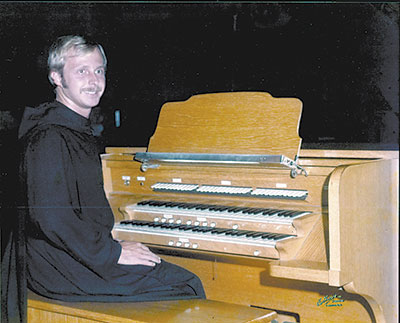 Father Morris Boyd, now retired from parochial vicar of St. Lawrence Basilica in Asheville, has a musical past. When he was a child growing up in Mobile, Ala., he became interested in the accordion, which later led to an interest in the organ.
Father Morris Boyd, now retired from parochial vicar of St. Lawrence Basilica in Asheville, has a musical past. When he was a child growing up in Mobile, Ala., he became interested in the accordion, which later led to an interest in the organ.
He initially took organ lessons at Oakdale Baptist Church for several years, studying with Sue Lamb Whatley, before attending the Benedictine college of St. Bernard Abbey in Cullman, Ala.
"When I went to St. Bernard, they were singing all of the music a capella," Father Boyd recalls. "They needed an organist, so they sent me to study with Dr. Betty Louise Lumby (professor of music and organ of the University of Montevallo in Alabama)."
For the next year he drove 82 miles each way to study with Lumby, while at the same time continuing his studies at St. Bernard Abbey. It was during this time that he discerned becoming a monk and entered religious life there.
"My organ practice time was built into my monastic schedule," he notes.
Father Boyd was later sent to St. Meinrad Archabbey where he studied organ with Benedictine Father Columba Kelly. "I was the organist for the theology chapel. I played once a week."
He was in the midst of his theology studies when an opportunity to consider becoming a diocesan priest for the Diocese of Charlotte presented itself.
"Bishop Michael Begley basically recruited me for the Diocese of Charlotte," Father Boyd says, laughing. "He talked to me for 45 minutes – I never got a word in edgewise. He says he hoped I'd consider becoming a priest for the Diocese of Charlotte." He was ordained on May 6, 1978.
Father Boyd, now 64 and a priest for 36 years, believes that his musical past has helped shape his priestly ministry.
"It taught me the basics of music and helped me understand the problems church musicians have. It taught me an appreciation for that."
He admits he is a functional musician. "I learned how to play hymns. I could do that very well."
But he hasn't played the 1909 Estey organ at St. Lawrence Basilica or picked up the accordion in years.
"I haven't been serious about it in a long, long time. I still love it. I still love my music. I love to hear music and I love to play music," but, he adds, "It's been a long time since I've had an opportunity to sit down at a keyboard."
He feels strongly that music enriches people's lives and expands their horizons.
"I had fun getting knowledge for what the church musicians go through. I can always sympathize with church musicians. And music is the way in which you get into another culture. It has certainly helped me with our Latino culture. You get more into a culture and more into the liturgy through the music."
FATHER ED SHERIDAN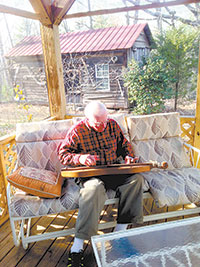 Father Ed Sheridan is now retired but that doesn't mean he has relaxed in his priestly ministry or in serving the community. He is now serving as a chaplain at the hospital in Hickory near where he lives. He also enjoys sharing a hobby of his from time to time: playing the mountain dulcimer.
Father Ed Sheridan is now retired but that doesn't mean he has relaxed in his priestly ministry or in serving the community. He is now serving as a chaplain at the hospital in Hickory near where he lives. He also enjoys sharing a hobby of his from time to time: playing the mountain dulcimer.
"I wanted to try playing the dulcimer when I was a young priest, but did not get the instrument until much later," Father Sheridan explains. "I took a course at Central Piedmont Community College in Charlotte in 1998."
He says he has played a few times in public in Charlotte, where he once served as pastor of St. Gabriel Church. He has also played for parish groups in Hickory.
"I am not proficient by any stretch of the imagination, but I do try to play it occasionally," he says. "My main repertoire is limited to a few hymns and a few Irish songs."
A North Carolinian by birth, he also appreciates that the mountain dulcimer is one of the few instruments which are native to the state.
"It is an easy instrument to play," he adds.
FATHER KEN WHITTINGTON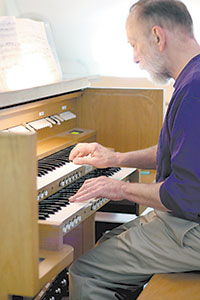 St. Charles of Borromeo Church in Morganton has been Father Ken Whittington's home for the past 23 years. It is a diverse parish of 600 Anglo, Guatemalan and Hmong families. Father Ken, as he prefers to be called, is a classically trained organist who is intimately involved in the parish's music ministry, rehearsing the choir in addition to his pastoral duties.
St. Charles of Borromeo Church in Morganton has been Father Ken Whittington's home for the past 23 years. It is a diverse parish of 600 Anglo, Guatemalan and Hmong families. Father Ken, as he prefers to be called, is a classically trained organist who is intimately involved in the parish's music ministry, rehearsing the choir in addition to his pastoral duties.
Father Ken, a convert to the Catholic faith, started playing the piano when he was 5 years old and began organ studies in seventh grade. When he was about 9 years old, he heard an organ piece by Mozart on the radio and it captivated him. He decided to study music, specifically the organ, after that. Upon completion of high school, he enrolled in the Peabody Conservatory of Music in Baltimore, Md. After completing a master's degree in performance, he was awarded a Fulbright Scholarship to continue his studies at the Staatliche Hochschule für Musik in Frankfurt, Germany, under renowned German organist Helmut Walcha, who is known for his recordings of the complete organ works of Johann Sebastian Bach. Walcha taught many of the 20th century's most significant American organists, who traveled to Germany as Fulbright scholars.
Like many of Walcha's students, Father Ken became a music teacher after completing his studies, serving as the head of the music department at Chatham Hall, a girl's preparatory school in Chatham, Va., for 10 years. He also later worked as a music director at an Episcopal church in Southport, Conn., and also in California.
While his music career kept him busy, he enjoyed traveling and he spent many summers in Europe. And even though he was not Catholic at the time, his studies and his travels took him to some of Europe's greatest cathedrals, and he became enamored with the Catholic faith, even spending three months at Solesmes Monastery studying chant.
That attraction to the faith and his love of church music led him eventually to Our Lady of Grace Church in Greensboro, where he had been recruited by its pastor, then Father Bill Pharr, to work as the parish music director.
"At first I said no," he recalls with a laugh. "After some negotiations, I said yes." Their close friendship was to be the catalyst for Father Ken's conversion to Catholicism and his vocation to the priesthood.
He entered the seminary and was ordained a priest of the Diocese of Charlotte in 1988 at the age of 46. After spending four years at St. Patrick Cathedral in Charlotte (known for its 1,492-pipe Zimmer organ), Father Ken was named pastor of St. Charles Borromeo Church.
At 73, he is going strong, offering daily Mass at the parish. He celebrates Mass in English, Hmong and Latin, and on occasion in German, and he is deeply involved in planning the music for the liturgy and directing the choir rehearsals.
"When I was ordained, I made a vow not to mix my priestly duties with my music," Father Ken says with a note of humor in his voice, adding that he quickly realized he couldn't keep that vow, especially with working in a small parish like St. Charles Borromeo.
What he loves most about playing the organ is that it requires a challenging coordination of hands and feet, he says.
"It's an extremely mechanical instrument. I am in awe at the power of it! I appreciate its range, from great delicacy to great power. So much of the music I really love is written for the organ."
Even though the organ at St. Charles Borromeo Church is a small electric organ that he purchased not long after he arrived in Morganton, Father Ken has his memories of playing some of Europe's most famous organs, including the Christian Muller 5,068-pipe organ at St. Bavo Church in Haarlem, Holland. Both Handel and Mozart played that organ.
"That is a beautiful organ – both to see and hear. It has hosted many great players throughout the centuries," he notes.
Father Ken says it has been a joy to share his musical talents with his parishioners, combining his love of the faith with his love of music, and he plans to continue his ministry for as long as the Lord will allow him. He is particularly looking forward to the music for the coming Christmas celebration.
"We do a lot of chant here. This Christmas we will sing traditional chant for Propers during our liturgy. We will sing the Kyrie, Gloria, Credo, Sanctus and Agnus Dei from Hans Leo Hassler's 'Missa Secunda,' which is very beautiful and simple." And, he says, the choir will also sing a setting of the Magnificat by Orlandus Lassus for Christmas.
— SueAnn Howell, senior reporter
The importance of the organ in Church music
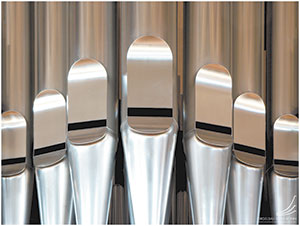 The pipe organ has played a pivotal role in the music of the Roman Catholic Church music for centuries. Even with the liturgical reforms brought about with the Second Vatican Council, the value of sacred music and the pipe organ were affirmed as ways to enable the laity to participate more fully at Mass and to lift their hearts up in solemn worship of God.
The pipe organ has played a pivotal role in the music of the Roman Catholic Church music for centuries. Even with the liturgical reforms brought about with the Second Vatican Council, the value of sacred music and the pipe organ were affirmed as ways to enable the laity to participate more fully at Mass and to lift their hearts up in solemn worship of God.
The 1963 Vatican II constitution "Sacrosanctum Concilium" ("On the Sacred Liturgy") stated, "In the Latin Church the pipe organ is to be held in high esteem, for it is the traditional musical instrument which adds a wonderful splendor to the Church's ceremonies and powerfully lifts up man's mind to God and to higher things." (120)
More online
Read more from " Sacrosanctum Concilium" as well as the follow-up Church document, "Musicam Sacram" ("Instruction on Music in the Liturgy," 1967)
Characteristics and Varieties of Dulcimers
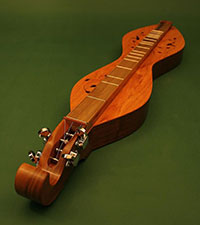 • Number of strings: Dulcimers may have as few as two or as many as 12 strings (in six courses). Instruments with only one string would more properly be termed monochords. In the 1950s and 1960s most mountain dulcimers had three strings. The most popular variant today is four strings in three courses, with doubled melody strings.
• Number of strings: Dulcimers may have as few as two or as many as 12 strings (in six courses). Instruments with only one string would more properly be termed monochords. In the 1950s and 1960s most mountain dulcimers had three strings. The most popular variant today is four strings in three courses, with doubled melody strings.
• Fret patterns: Until the late 1970s, most Appalachian dulcimers were made with a purely diatonic fretboard. A few years later, an added 6½ fret (and where the instrument fretboard is long enough, the 13½ fret, an octave higher) had become standard. Most makers now offer 1½ and 8½ frets as options, and the fully chromatic dulcimer is rising in popularity.[7]
• Body shapes: Dulcimers appear in a wide variety of body types, many of which are recorded in "A Catalog of Pre-Revival Dulcimers". A representative array would include: hourglass, teardrop, trapezoid, rectangular, elliptical ("Galax-style"), violin-shaped, fish-shaped, and lute-back.
• Materials: In addition to plywood, laminates, and solid woods, some builders are using experimental materials such as carbon fiber. Dulcimers are also made of cardboard. Often sold as low-cost kits, cardboard dulcimers offer surprisingly good sound and volume. Their low cost and resistance to damage make them particularly suited to institutional settings, such as elementary school classrooms.
• "Courting dulcimers": One unusual variant is the "courting dulcimer." This instrument consists of one large dulcimer body with two separate fingerboards. The instrument is laid across the laps of two facing individuals (the eponymous "courting" pair) and used to play duets.
• "Double-Neck Dulcimers": Somewhat the same as a "courting dulcimer", but with both fretboards (or "necks") facing the same direction. Popularized by performer Bing Futch, it allows for multiple tunings without changing instruments.
• "Bowed Dulcimers": Dulcimers that can be played with bows; in the modern era heavily modified variants have been made exclusively for bowed playing.
Modern dulcimer variants
• Guitar dulcimer: a hybrid of guitar and dulcimer, with the body more closely resembling a guitar, but the string configuration and pegs of a dulcimer. This variant was first explored, and later patented, by Homer Ledford and called the "dulcitar."
• Banjo dulcimer: resembles a standard dulcimer, but with a banjo-head on the body. This variant was first explored, and later patented, by Homer Ledford and called the "dulcijo." Similar instruments include the "Ban-Jammer" (Mike Clemmer), the "Banjimer" (Keith Young) and the "Banj-Mo" (Folk Notes). The "Dulci-Jo" is a banjo/dulcimer hybrid with a thumb string like a clawhammer banjo, 3 strings and a diatonic fret pattern, shaped more like a banjo and played upright, and built by Michael Fox of NC.
• Resonator dulcimer: a standard dulcimer, with a resonator added to the body, in imitation of the resonator guitar. This variant was first explored, and later patented, by Homer Ledford and called the "dulcibro."
• Electric dulcimer: acoustic dulcimers may be electrified with pickups, and several builders produce solid-body electric dulcimers.
• Aquavina: a dulcimer employing a metal resonator filled partially with water. The resonator is agitated while playing, producing an eerie oscillation of the harmonics.
• Dulcitar or stick dulcimer: a long-necked fretted instrument, similar to a guitar or mandolin, with diatonic dulcimer fretting. These instruments are known by a wide variety of names, with the most common commercial model being the "McNally Strumstick."
-Wikipedia
Why is the pipe organ so special?
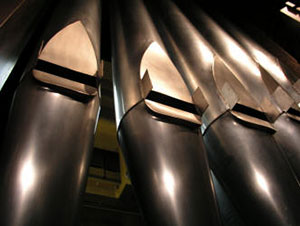 An organ is a keyboard instrument, operated by the player's hands and feet, in which pressurized air produces notes through a series of pipes organized in scalelike rows. The term organ encompasses reed organs and electronic organs but, unless otherwise specified, is usually understood to refer to pipe organs. Although it is one of the most complex of all musical instruments, the organ has the longest and most involved history and the largest and oldest extant repertoire of any instrument in Western music.
An organ is a keyboard instrument, operated by the player's hands and feet, in which pressurized air produces notes through a series of pipes organized in scalelike rows. The term organ encompasses reed organs and electronic organs but, unless otherwise specified, is usually understood to refer to pipe organs. Although it is one of the most complex of all musical instruments, the organ has the longest and most involved history and the largest and oldest extant repertoire of any instrument in Western music.
In spite of far-ranging technical developments, the organ's basic principles of operation remain substantially unchanged from when they were discovered more than 2,000 years ago. Conventional pipe organs consist of four main parts: a keyboard or keyboards and other controls, pipes to produce the tone, a device to supply wind under pressure, and a mechanism connected to the keys for admitting wind to the pipes. The most basic instrument consists of a single set, or rank, of pipes with each pipe corresponding to one key on the keyboard, or manual. Organs usually possess several sets of pipes (also known as stops, or registers), however, playable from several keyboards and a pedal board. Under their control are the various ranks of wooden and metal pipes of differing length and shape. These fall into the two distinct categories of flue pipes and reeds.
The pipes are arranged over a wind chest that is connected to the keys via a set of pallets, or valves, and fed with a supply of air by electrically or mechanically activated bellows. Each rank is brought into action by a stop that is connected by levers, or electrically, to a slider. To bring a pipe into speech the player must first draw a stop to bring the holes in the slider into alignment with the foot of the pipes on the toe board. Pressing a key causes the pallet under that pipe to open, allowing air to travel along a narrow channel, through the slider hole, and into the pipe.
Mechanical action, until the 19th century the sole method of linkage between pipe and keyboard, is still commonplace. The usual forms of mechanically aided action are tubular pneumatic, electro-pneumatic, and direct electric. An organ is generally disposed in divisions, each with a number of separate ranks controlled by separate manuals (two manuals and pedals are the minimum required to play the bulk of the legitimate repertoire). A large instrument may have five, or exceptionally more, manuals banked above each other, each controlling families of tones and pitches.
A characteristic of the organ is the freedom it allows the player to build up the volume and timbre by adding, to the basic tone, stops of proportionately higher or lower pitch. The pitch of any pipe is proportional to its length. Thus, an 8-foot (2.4-metre) pipe will sound at normal keyboard pitch, one of 16 feet (5 metres) will sound its sub-octave, and one of 4 feet (1 metre), its octave. Mutation stops sound at pitches corresponding to the harmonics of unison pitch. Pipes may vary from 32 feet (10 metres) long to less than 1 inch (2.5 cm), giving the organ a possible range of nine octaves—larger than any other instrument.
The earliest known organ was the hydraulis of the 3rd century bce, a rudimentary Greek invention, with the wind regulated by water pressure. The first recorded appearance of an exclusively bellow-fed organ, however, was not until almost 400 years later. By the 8th century organs were being built in Europe, and from the 10th century their association with the church had been established. The 15th and 16th centuries witnessed significant tonal and mechanical advances and the emergence of national schools of organ building. By the early 17th century all the essential elements of the instrument had been developed, and subsequent developments involved either tonal changes or technological refinements.
It was during the High Baroque period that the organ reached its greatest popularity and found its most important composer in Johann Sebastian Bach (1685–1750). There existed at this time two principal schools of organ building: the French, with its colorful reeds and mutations, and the German and Dutch, with their outstanding choruses.
After the death of Bach, organ building entered into a gradual decline, most particularly in Germany and England, where organs built after 1800 were of increasingly poor tonal quality. There was, however, more emphasis on orchestrally imitative stops. The 19th century also saw the widespread introduction of reed organs, such as the harmonium and the melodeon. Reed organs produce sound by using freely vibrating reeds (rather than the beating reeds used in the reed pipes of pipe organs), usually without resonators. Smaller and less complicated than pipe organs, they remained popular in homes and small institutions until the early 20th century, when they lost ground to electronic organs and mass-produced pianos.
-www.brittanica.com


